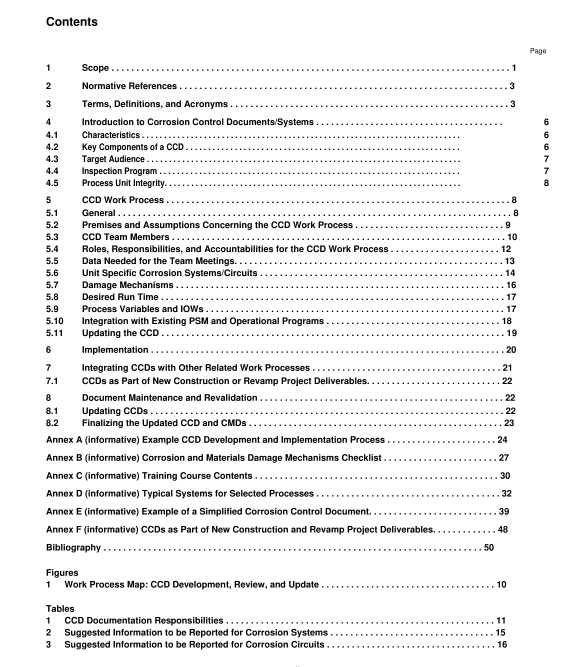API RP 970 pdf download

API RP 970 pdf download Corrosion Control Documents
4.3 Target Audience
The primary audience for RP 970 is engineering and inspection personnel who have a major role in maintaining the mechanical integrity of equipment covered by this RP. However, while an organization’s Corrosion/Materials Engineering group may champion the CCD program, the creation and use of CCDs is not exclusively a Corrosion/ Materials Engineering group activity. A Corrosion Control Document program developed in accordance with this RP needs the involvement of various segments of the organization, such as Inspection, Process Engineering, Maintenance and Operations.
The implementation of the resulting CCD product (e.g. plant-wide use as a reference for process descriptions, corrosion/damage mechanisms, IOWs, project planning, and MOC) may rest with more than one segment of the organization. CCDs need the commitment and cooperation of the total plant operating organization. In this context, while the primary users may be corrosion/materials engineering and inspection personnel, other stakeholders who are likely to be involved in the CCD development, maintenance and implementation process should be familiar with the concepts and benefits offered by CCDs.
4.4 Inspection Program Historically, inspection plans in most process plants have been based upon the prior recorded/known history of equipment condition and the requirements of API 51 0, API 570 and Standard 653.
A fundamental understanding of the process/operating conditions and resulting damage mechanisms is needed to establish and maintain an inspection program that yields the highest probability of detecting potential damage. Inspection plans should be dynamic and account for changing process conditions and current equipment condition. A fundamental step is the timely alignment with a developed knowledge base of the materials of construction with the operation of the equipment, its inspection history, relevant damage mechanisms, measured corrosion/erosion rates and known industry incidents. It is vital to identify and track process information that validates or suggests changes to existing inspection plans. Changing process conditions should be communicated to the Corrosion/Materials/ Inspection group for inspection plans to be adjusted, when necessary, to account for those changes. For more information on inspection planning, refer to Section 5 of API 51 0 and API 570. Establishing and using information collected during the CCD creation process will help improve and sustain a properly structured inspection program. A detailed CCD can become part of the front-end data input to the RBI process. Inadequately controlled processes/operations may result in unanticipated damage that inspection programs are generally not designed to find. Under past practices, inspection programs generally assumed that the next inspection interval (calculated based on prior damage rates from past operating experience) should be scheduled on the basis of what is already known and predictable about equipment damage from previous inspections. Without effective process control based on an accurate and complete list of IOWs, inspections may need to be scheduled on a less than optimum time-based interval just to look for damage occurring from lack of adequate process control. API RP 584 should be used in conjunction with this document when creating and implementing IOWs. The work processes are very similar.
4.5 Process Unit Integrity For purposes of this document, maintaining the integrity of the process unit means avoiding breaches of containment, and reliability means avoiding malfunctions of the pressure equipment that might impact the process unit performance (meeting its intended function for a specified time-frame). In that sense, integrity is a part of the larger issue of pressure equipment reliability, since most breaches of containment will impact reliability. Pressure equipment is generally fabricated from the most cost effective materials of construction to meet specific design criteria for the equipment’s intended life based on the intended operation and process conditions. The operating process conditions are then controlled within limits (IOWs) to avoid unacceptable construction material damage and enable damage control, monitoring, and inspection activities to safely predict if and when repairs or replacements will be needed.
5 CCD Work Process
5.1 General In this section a general work process is outlined for establishing, implementing and maintaining CCDs. An example of a more detailed CCD implementation checklist and work flow process appears in Annex A. For examples that closely follow the flow outlined in this section, see Annex E. NOTE This work process may be applied to a single equipment item, multiple equipment items in a group (corrosion circuit), or more generally, to the overall process unit. The work process may be standalone or part of an integrated mechanical integrity management work process. The outline given in this section and the example process given in Annex A are not intended to require operators to create a new work process if the operator has an existing process covering the same elements (e.g. an “Asset Strategy Process”, etc.).









